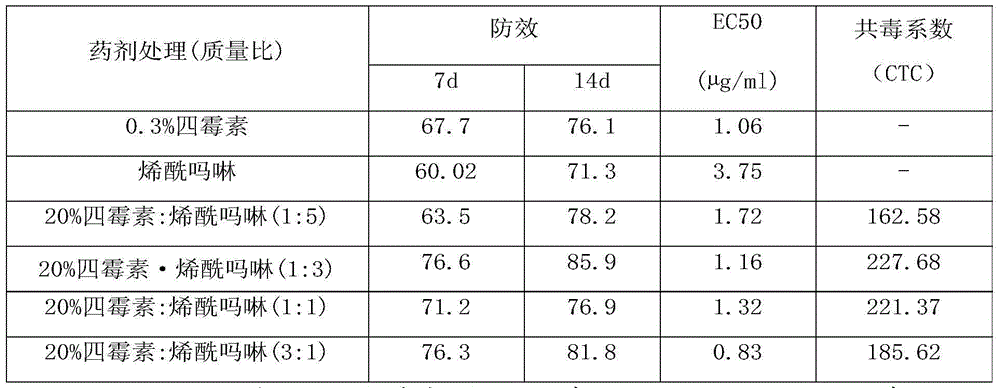Tetramycin compound and application
A technology of tetramycin and compound, applied in the field of biopesticide formulation research and development, can solve the problems of no effect, no harvest of particles, replay of destroyed fields, etc., and achieves the effect of extending the service life, reducing the risk, and increasing the bactericidal spectrum. Effect
- Summary
- Abstract
- Description
- Claims
- Application Information
AI Technical Summary
Problems solved by technology
Method used
Image
Examples
example 5
[0061] Example one tetramycin and dimethomorph complex
[0062] Wherein, dimethomorph is selected as the active material component. The original drugs of tetramycin and dimethomorph were made into 20% suspension concentrate respectively, and the indoor pot experiment was carried out. The test method was carried out with reference to Wu Wenjun's "Introduction to Experimental Techniques of Plant Chemical Protection" (1993). According to the requirements of the experiment, single doses and types with corresponding mass ratios were made respectively. The specific data of the test results are shown in Table 1.
[0063] Table 1 Indoor pot test data of tetramycin and dimethomorph.
[0064]
[0065] Calculate the toxicity index of each agent and the co-toxicity coefficient (CTC value) of the mixture according to Sun Yunpei's method. When CTC ≤ 80, it is antagonistic, 80﹤CTC﹤120 is additive, and CTC ≥ 120 is synergistic.
[0066] In the indoor colony inhibition test, it was foun...
example 6
[0070] Example tetramycin compounded with chlorothalonil
[0071] Among them, chlorothalonil is selected as the active material component, and its chemical name: tetrachloroisophthalonitrile (2,4,5,6-tetrachloro-1,3-benzenedicyanonitrile), is a broad-spectrum, protective bactericidal agent. The mechanism of action is that it can interact with glyceraldehyde triphosphate dehydrogenase in fungal cells, and combine with the protein containing cysteine in the enzyme, thereby destroying the activity of the enzyme, destroying the metabolism of fungal cells and losing vitality . Chlorothalonil has no systemic conduction effect, but after being sprayed on the plant body, it can have good adhesion on the body surface and is not easily washed away by rain, so the drug effect period is longer.
[0072] It is used to control various fungal diseases of fruit trees, vegetables, and cereal crops, especially for the control of wheat powdery mildew.
[0073] The content of the present inv...
Embodiment 2-1
[0075] Toxicity determination of tetramycin mixed with chlorothalonil against wheat powdery mildew
[0076] 1) Drug preparation
[0077] Tetramycin solution: Accurately weigh the tetramycin mother solution and dilute it to a concentration of 25, 12.5, 6.25, 3.125, 1.5625mg / L for later use.
[0078] Chlorothalonil solution: Accurately weigh 0.01g of the original drug with a weight concentration of 97% chlorothalonil, dissolve it with 0.2ml dimethylformamide, add 97ml of clear water containing 0.1% Tween 80 surfactant, stir evenly, and prepare chlorothalonil Bacteria clear 100mg / L mother solution, then diluted with clear water containing 0.1% Tween 80 surfactant to 50, 25, 12.5, 6.25, 3.125mg / L concentration for subsequent use.
[0079] Each mixed solution: take 5, 3, 3, 3, 2ml 100mg / L tetramycin solution respectively, add 5, 9, 15, 21, 18ml 100mg / L chlorothalonil solution to make 50mg / L tetramycin Element: chlorothalonil 1:1, 1:3, 1:5, 1:7, 1:9 solution, then diluted with wat...
PUM
 Login to View More
Login to View More Abstract
Description
Claims
Application Information
 Login to View More
Login to View More - R&D
- Intellectual Property
- Life Sciences
- Materials
- Tech Scout
- Unparalleled Data Quality
- Higher Quality Content
- 60% Fewer Hallucinations
Browse by: Latest US Patents, China's latest patents, Technical Efficacy Thesaurus, Application Domain, Technology Topic, Popular Technical Reports.
© 2025 PatSnap. All rights reserved.Legal|Privacy policy|Modern Slavery Act Transparency Statement|Sitemap|About US| Contact US: help@patsnap.com



